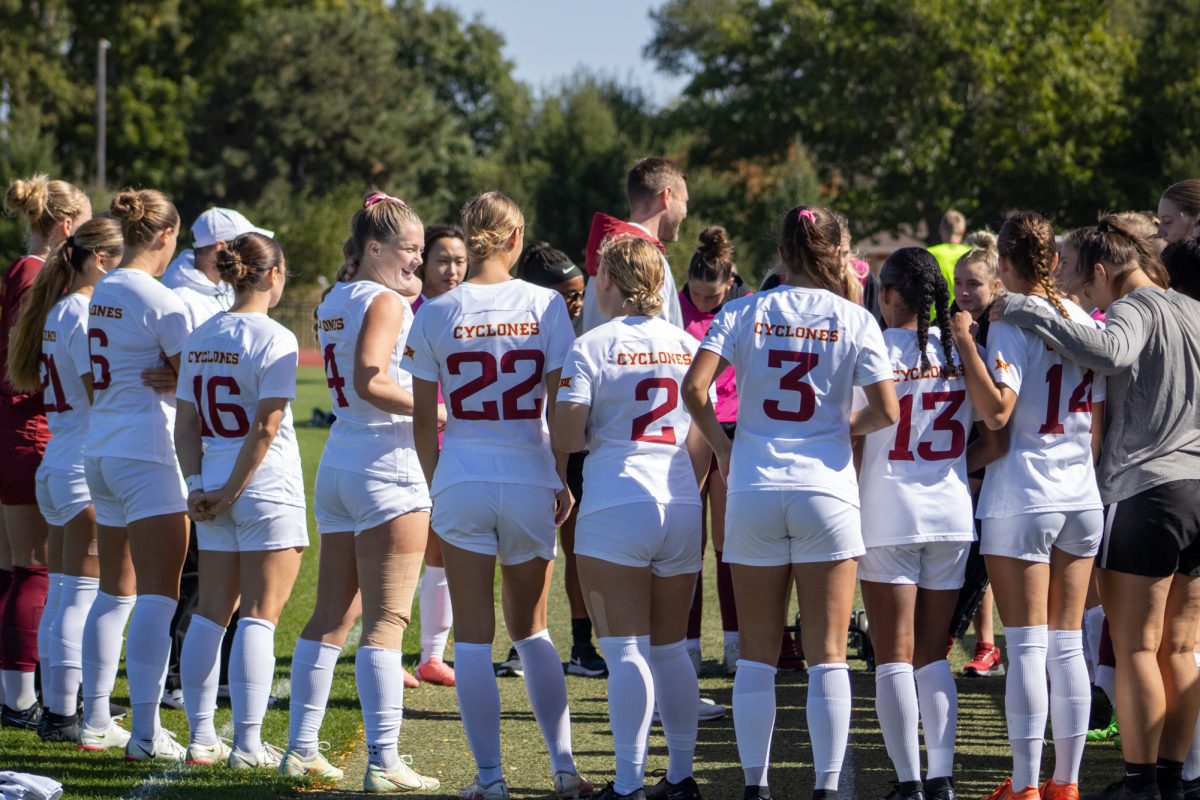Talking Connections: What is a relationship?
Relationships come in many forms, from platonic to romantic to sexual, and all are connected in some way.
January 29, 2020
Editor’s Note: In the spring 2019 semester, the Iowa State Daily introduced “The Talk,” a series with the goal to open up a discussion about sexual intimacy among our readers. In the fall 2019 semester, we introduced “Talk About It,” a series discussing mental health. This semester, we are starting the series “Talking Connections” to dive into the different types of relationships and their purpose.
Throughout this series, we will discuss issues such as breakups, fear of intimacy, how to build friendships and more. For the rest of the semester, we plan to publish one story each week addressing a topic related to relationships.
Our hope is by the end of the series, we may have opened our readers up to discussions in ways they hadn’t thought of or may not have felt they were able to speak about before.
Everyone has a type of connection, so let’s get talking.
Relationships come in many forms, from platonic to romantic to sexual, and all are connected in some way.
A relationship is defined as “the state of being related or interrelated; the relation connecting or binding participants in a relationship such as kinship; or a state of affairs existing between those having relations or dealings such as a romantic or passionate attachment,” according to the Merriam-Webster dictionary.
As this definition describes, what a relationship is can be pretty vague. Relationships can come in many forms, and each form can have a different definition depending on who is in that particular relationship.
“When discussing relationships, people may instantly guess romantic relationships,” said Amy Popillion, teaching professor of human development and family studies. “Relationships are anytime there is this ongoing connection between people. Anytime you are actively pursuing a continued interaction with a person, that is a relationship.”
Strong relationships are continually nurtured with care and communication, Popillion said. She said although relationships can take many forms, for healthy relationships to form, communication between partners is key, no matter the type of relationship.
“In the 21st century, good relationships are generally marked by a sense of fairness, emotional as well as physical,” according to the Psychology Today website. “Partners in strong relationships also feel grateful for one another, openly provide and receive affection and engage in honest discussions about sex, if that is part of the relationship.”
Another core piece of any relationship is that it has boundaries. Popillion said these boundaries are usually not talked about but instead form organically.
Some friends may want to share everything with one another, and others may want to keep their privacy. With any boundaries, they can change in time, and the people involved may see how far their boundaries stretch, but ultimately, both people should be respectful of boundaries as they develop or are discussed.
PLATONIC
“The idea of what a platonic relationship is has evolved over the years,” according to the Regain website. Regain is an online relationship counseling platform. “The person who came up with the concept was the philosopher Plato, whose name makes the term.”
Plato’s definition of what platonic love is differs from what the modern interpretation is. His definition of love was one that wasn’t about lust but instead love that would bring a person closer to the divine and brought out the best traits in that person. It applied to all forms of relationships.
The modern definition of platonic love still has some of Plato’s ideas, such as the idea of a bond that brings the best out of the two people involved, but platonic love now centers around the idea of two people “being just friends,” according to the Regain website.
Nowadays, most people call platonic relationships ‘friendships’, and these can also come in many forms, from acquaintances to friends to best friends and even to “extended family.”
According to the Regain website, a platonic relationship is usually viewed as two people who are friends, but there is no sexual activity involved. Friends with benefits is not a platonic relationship.
The opposite of a platonic relationship is a romantic or sexual relationship.
Two people may have an honest platonic relationship, where there were no sexual or romantic feelings for one another at the start. However, there is always a chance a platonic relationship can turn into a romantic one. Mindsets change, and some people have to have a deep connection before they have any romantic relationship.
“A platonic relationship becoming romantic can be either the next step in your relationship, or it can be what comes crashing it down if the feelings are unrequited,” according to the Regain website. “By expressing your feelings, you may discover that your friend also has feelings for you. However, if they don’t, it can feel awkward. A friendship may not return to the status quo when it’s discovered there is unrequited love.”
The Regain website also stated that if a person is unsure if the other person in the platonic relationship has the same romantic feelings, they may want to take a break for a while and just distance themselves from that person instead of risk being dismissed.
“To summarize, platonic relationships can work well, but we are all human,” according to the Regain website. “Sometimes, romantic feelings may develop, and it can make the relationship more difficult. A true platonic relationship, where neither of you has sexual or romantic feelings, is quite rare, and it should be cherished.”
ROMANTIC
“A romance is a relationship between two people who are in love with each other,” according to the Collins dictionary.
Romantic love has inspired poets for centuries and been the subject of plays, songs, movies and any other creative or artistic endeavor a person can think of.
Sheri Stritof, writer for Very Well Mind, said this is because “As anyone who’s been in love knows, love is complicated and capable of eliciting strong emotions, from elation to heartbreak.”
Love is one of the most profound emotions known to human beings. There are many kinds of love, but many people seek its expression in a romantic relationship with a compatible partner or partners.
“For many, romantic relationships comprise one of the most meaningful aspects of life, providing a source of deep fulfillment,” according to the Psychology Today website. “The need for human connection appears to be innate — but the ability to form healthy, loving relationships is learned.”
Love relationships go through ups and downs — from that initial “honeymoon” phase to a sense of disappointment to a state of acceptance and a desire for permanence, according to the Psychology Today website. It can be challenging to move through these phases, but the reward may be a healthy, long-term relationship.
Romantic relationships do not have to include sexual feelings or sexual interactions between the partners involved, but those relationships can, in which case they are both sexual and romantic relationships.
“When we think about romantic relationships, they automatically think ‘Oh, you know romantic relationship means it is going to be the love and romance and the intimacy and the sex,’” Popillion said. “But for some people, that type of relationship may look different. For folks who are asexual, for example, they can still have a romantic relationship, but maybe sex isn’t involved or isn’t a primary part of that relationship.”
SEXUAL
Many experts agree sexual relationships work best when everybody is clear about what they want. All partners involved should make their intentions clear because one person might be looking for a fling and the other a marriage.
“Many people confuse love, commitment and sex or assume the three always go hand-in-hand,” according to the American Sexual Health Association website. “There are many ways to express love, and you don’t need to have sex with someone to show them you love them. Having sex with someone also does not necessarily mean you are in love with them.”
Having sex in a committed relationship can make people feel closer and more loving. Having sex in a non-committed relationship can also be a lot of fun and can make people feel like better friends.
“Whether you have a one-night fling or a fifty-year marriage, it is very important that you like, respect and trust your partner and that you feel liked, respected and trusted by them as well,” according to the American Sexual Health Association website.
The American Sexual Health Association website also stated there are a variety of different sexual relationships people may be involved in.
Mutual serial monogamy is a common relationship structure among many adults. This type of sexual relationship is when someone only maintains one long-term sexual partnership at a time, in which both partners are monogamous, which means they have sex only with each other.
Lifetime mutual monogamy is a type of sexual relationship where each person has only one sexual partner in a lifetime, which means both partners only have sex with each other.
Mutual fidelity is similar to mutual monogamy except there may be more than two people involved in this kind of relationship. Groups of three, four or more may have sexual relationships with one another but not have sex with anyone outside the group.
Sexually non-monogamous relationships include consensual, honest non-monogamy such as “casual dating,” swinging, polyamory and open relationships, as well as non-consensual/dishonest non-monogamy, also known as cheating. There are a wide variety of sexually non-monogamous relationship structures people may choose, in which one or more members of a couple or group have sex with others.
“Your relationship story is your relationship story,” Popillion said. “I think sometimes we try to pattern our stories off of what we’ve seen portrayed to us, but be careful to focus on making sure your relationship works for you and your partner, not fitting it to a ‘standard.’”







